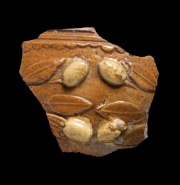Difference between revisions of "Vitreous"
Jump to navigation
Jump to search
(username removed) |
|||
| Line 1: | Line 1: | ||
| − | [[File:Image3_802355.jpg|thumb| | + | [[File:Image3_802355.jpg|thumb|Fragment with vitreous glaze<br>MFA# 03.864]] |
== Description == | == Description == | ||
| − | A descriptive term for a material that have glassy characteristics. Vitreous materials may be transparent, hard, brittle, amorphous, glossy and isotropic. Many metallic oxides (silicon, boron, germanium, arsenic, phosphorus, etc.) have the ability to form a glassy substance. | + | A descriptive term for a material that have glassy characteristics. Vitreous materials may be transparent, hard, brittle, amorphous, glossy and isotropic. Many metallic oxides ([[silicon]], [[boron]], [[germanium]], [[arsenic]], [[phosphorus]], etc.) have the ability to form a glassy substance. |
== Additional Images == | == Additional Images == | ||
<gallery> | <gallery> | ||
| − | File:Image3_802425.jpg| | + | File:Image3_802425.jpg|thumb|<br>MFA# 25-6-72 |
</gallery> | </gallery> | ||
[[Category:Materials database]] | [[Category:Materials database]] | ||
Revision as of 14:43, 25 June 2022
Description
A descriptive term for a material that have glassy characteristics. Vitreous materials may be transparent, hard, brittle, amorphous, glossy and isotropic. Many metallic oxides (Silicon, Boron, Germanium, Arsenic, Phosphorus, etc.) have the ability to form a glassy substance.

